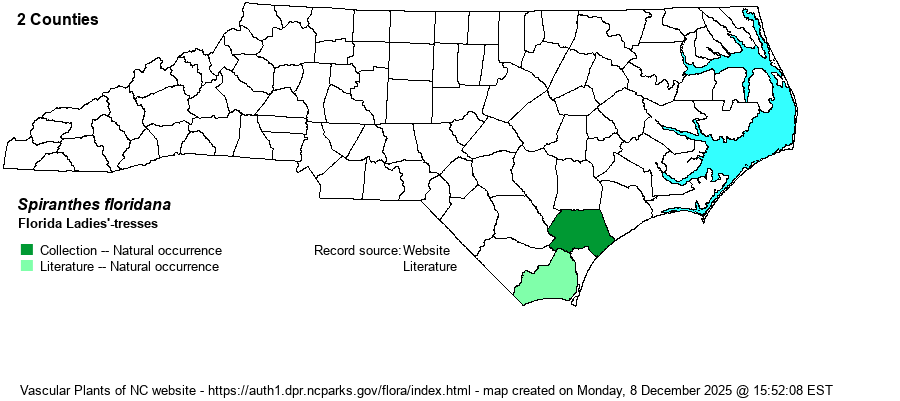| Author | (Wherry) Cory | |
| Distribution | Known so far only from 2 counties in the southeastern Coastal Plain -- Brunswick and Pender. Currently thought to be extant only in Brunswick County (fide R. LeBlond). The Pender specimen was from the Big Savanna in 1925 and has not been seen in the remnants. Specimens from Beaufort County (at DUKE and AMES) prove to be S. eatonii (fide P.M. Brown and B.A. Sorrie).
This is Southern species found mainly in FL, but scattered near the coast north to southeastern NC, and west to southeastern TX. | |
| Abundance | Extremely rare, perhaps overlooked as a more common or widespread species. The NC NHP has only one current location, in Brunswick County, and even that is a vague report with few data. As a result, they consider it to be a state Significantly Rare species. As NatureServe considers it as a G1 species, this is clearly an extremely rare species in its range and is declining owing to fire suppression of its mostly savanna habitats. It ought to be Federally listed as Endangered or Threatened. | |
| Habitat | This is a species of quite damp "grassy" places, mainly in savannas in the state. |
| Phenology | This species blooms in the spring, mainly in April and May. | |
| Identification | There are so many species of Spiranthes in NC, all of which are white-flowered and of a somewhat similar overall aspect, that for most biologists separating one from another can be difficult. This is one of several savanna species that blooms in the spring. However, it can most readily be separated from others by the flowers being a bit creamy-colored as opposed to clear white, the lip being yellow inside as opposed to green or green-striped, and a flower cluster that is mostly secund (arranged all to one side of the stem) as opposed to distinctly spiraled. It averages about 1.5-2 feet tall, with a few persistent grass-like leaves at the base. The inflorescence can be up to 15 inches tall in FL, but it is probably shorter on Carolina plants. Most of the information on the identification of this orchid comes from the North American Orchid Conservation Center website. Because it is a critically endangered species, in NC and even globally, any new discovery of the species in NC would be an excellent find. | |
| Taxonomic Comments | This has been considered as a valid species for many decades. However, for a good portion of the last century it was considered part of the Spiranthes gracilis complex; RAB (1968) considered it as a variety, named as S. gracilis var. floridana.
| |
| Other Common Name(s) | None | |
| State Rank | S1 | |
| Global Rank | G1 | |
| State Status | SR-P | |
| US Status | | |
| USACE-agcp | FACW link |
| USACE-emp | FAC link |

